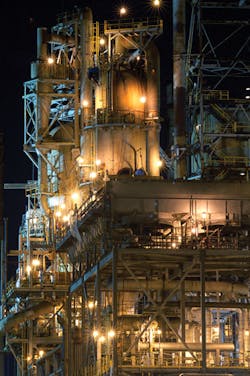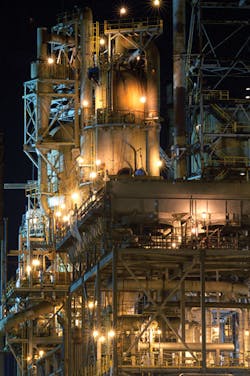Better asset management
COMMITTING TO PROFESSIONAL ASSET MANAGEMENT WILL INCREASE RETURNS
MIKE ASQUINI, T. A. COOK, DALLAS
AS IN ANY COMMODITY INDUSTRY, the number one concern in the refining business is to produce at the lowest cost and the highest profit. To be as competitive as possible, a site must create the most lucrative products at the most opportune times, which requires a high level of asset availability and a professional asset management plan.
While the cost of losing operating licenses or overspending on regular maintenance is higher than establishing a functional maintenance routine, achieving that is much easier said than done. Referring to the fixed, long-term, and tangible parts of a refinery necessary for production, this article sets out four key areas where having a professional approach to asset management can help lay a foundation for a sustainable financial future.
STARTING WITH STRATEGY
A professional plan of action should be created as a joint effort between the operations, maintenance and finance departments. To align repairs with commercial targets, policies, and objectives, an asset management strategy should detail the best way to handle equipment in regards to safety, environmental impact, human resources, processes and systems. As assets undergo depreciation with time, companies must implement a variety of techniques to help sustain performance.
In order to guarantee output and follow the preferred production plan without interference, assets must be consistently available. The irony of asset management is that working on maintaining strong availability requires temporary unavailability: decision makers must find a balance between the two and weigh the cost of scheduling the down time necessary for maintenance work with the price of what that blocked maintenance time means. Although shutting down equipment for any amount of time represents lost revenue, the earned value of maintaining and managing assets is undeniable.
MAINTENANCE DISCIPLINE
As such, preserving an exceptional level of production requires a good amount of discipline and consistency. To achieve that, a combination of regulatory, predictive and preventative activities is required; each of which exist to extend the life of equipment. Corrective work comes into play when there is a surprise or deficiency with the other regularly scheduled maintenance tasks. If corrective work is necessary, management should always analyze the reason behind it so that in the future, the problem is corrected within the preventative or predictive maintenance stages. If corrective repairs can be avoided, costs can be better controlled and the refinery's time, energy and finances can be better utilized.
With that in mind, organizing routine maintenance and asset management work should be a priority. A site's resources need to be earmarked for these regularly occurring activities with the responsibility shared between the maintenance and the operations departments. Although most activities will be carried out by the maintenance department, operations personnel participate in minor upkeep on a daily basis and take part in larger projects, such as turnarounds and shutdowns.
In order to contribute effectively, routine maintenance should be coordinated with regular operations activities. All operations employees must have defined roles, be aware of expectations and be properly trained to carry out their asset management duties. As part of a long-term plan, it is ideal if employees are skilled workers who can perform maintenance and operations tasks equally well.
PLANNING AND SCHEDULING
Planning and scheduling are the nuts and bolts of asset management preparation: efficiency can increase by as much as 20% with a reliable plan in place. To ensure the best results, planning and scheduling should be handled as two separate entities. During the planning phase, individual tasks and the resources required to complete them, should be specified in detail. To do this, managers need to verify all work requests and define the scope. Planners are responsible for organizing the labor, materials, drawing and specifications for each job. The ultimate goal is to bring everything and everyone together at the right place and the right time.
Scheduling takes place once the required assets are on hand. To prepare the schedule, all details from work logistics, such as transportation, to what is already on the backlog, need to be considered. The schedule helps planners arrange for resources to be available when they are expected. Fluid interdepartmental communication is especially important at this stage.
TURNAROUNDS
Asset management work includes not only routine maintenance: turnarounds and cost-justified capital improvement projects are also essential aspects of a viable financial plan. Turnarounds are one of the most expensive and complex maintenance projects a heavy industry producer can conduct. The preparation process of a major turnaround can take up to three years and requires expertise and significant investment. Although every site hopes to conduct a turnaround on schedule and within budget, this is frequently easier said than done.
Comprehensive work requests are the first step to put a turnaround on track. Just as in routine maintenance planning, all employees must be trained to propose work. Managers are responsible for performing a cost-benefit analysis with consideration to a site-specific set of criteria. If the work fits in with the schedule and overall scope, it can be planned and subsequently scheduled. Of course, only work requests that must be completed when all equipment is shut down should be approved during a turnaround.
Asset management work performed during a turnaround should be scrutinized much more critically than normal work orders because it is much more expensive. During a shutdown, work will cost three to five times more to complete than if it were carried out during regular working times. This is why turnarounds only include tasks that must be completed when all equipment is shut down.
Once the turnaround scope has been fixed, managers have to assign employees to complete the tasks. For large projects, such as turnarounds, that usually means bringing in contracted labor. Managing contractors is often more complicated than salaried team members, beginning with the bidding process. In order to have competitive bidding, the scope first needs to be well-constructed and predetermined. This way, contractors will be more willing to negotiate deals in which they share the risk and offer the hiring site the most economical rate.
CONCLUSION
If managed properly, assets will last longer, perform better, and be more reliable. By committing to professional asset management strategy as highlighted in this article, refineries will be better placed and informed to make the right decisions to ensure the highest flexibility. Through a combination of best practice techniques, stakeholders will enjoy a welcome return in this competitive industry.
ABOUT THE AUTHOR
With more than 20 years' experience in the energy sector, Mike Asquini provides clients in the oil and gas sector with expert productivity advice. Previously a project manager for Advanced Productivity Services and Synergetics Installations Worldwide, he joined T.A. Cook in 2010 and has been a manager since 2014. Asquini currently provides consulting services to asset intensive businesses in the refining and petrochemical industries. His work supports clients with maintenance optimization, turnaround, asset management, shutdown optimization, and OEE improvement across North America.


